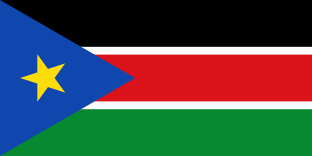Rail transport in Kenya
Rail transport in Kenya consists of a metre-gauge network that is in poor condition and a new standard gauge railway (SGR). Both railways connect Kenya's main port city of Mombasa to the interior, running through the national capital of Nairobi. The metre-gauge network runs to the Ugandan border, and the Mombasa–Nairobi Standard Gauge Railway, financed by a Chinese loan, is being extended to the Ugandan border as of June 2017.
Network
- Narrow gauge: 2,778 km 1,000 mm (3 ft 3 3⁄8 in) gauge, some lines abandoned
- Standard gauge: 605 km 1,435 mm (4 ft 8 1⁄2 in)
- Mombasa–Nairobi Standard Gauge Railway (SGR)
- SGR extension to Naivasha
Railway links with adjacent countries





- The Mombasa–Nairobi Standard Gauge Railway will be extended to the Uganda border, connecting with a standard gauge railway in Uganda.
Passenger services
Passenger service between Mombasa and Nairobi is available on the Mombasa–Nairobi Standard Gauge Railway. A metre-gauge commuter train connects the new SGR Nairobi Terminus to the old station in Nairobi city center.
History
The Uganda Railway was originally built by the British to provide Uganda with access to the sea. Construction began at Mombasa in 1896 and reached Lake Victoria in 1901. The line was nicknamed the Lunatic Line because of the difficulties encountered during its construction, including man-eating lions that ate about 30 workers before they were finally hunted down. In 1929, the Uganda Railway was merged into Kenya and Uganda Railways and Harbours, which was then merged into East African Railways and Harbours Corporation (EAR&H) in 1948. EAR&H operated transportation links for Kenya, Uganda, and Tanzania until the East African Community was dissolved. Kenya's portion of the railway became the Kenya Railways Corporation. Over the next 30 years, Kenya's railway network deteriorated from a lack of maintenance. By 2017, only half of Kenya's metre-gauge railways remained in operation.[2]
In November 2006, the Rift Valley Railways Consortium took over the operation of railways in Kenya and Uganda under a 25-year concession.[3] However, RVR was unable to turnaround railway operations, hampered by corrupt management and aging infrastructure. In 2017, the World Bank found that a $22 million loan extended for the purchase of refurbished locomotives had been diverted into a shell company controlled by RVR executives.[4] The Uganda Railways Corporation issued a notice of default to RVR in 2016,[5] and the Kenya Railways Corporation terminated the concession in April 2017.[6]
In 2011, Kenya signed a memorandum of understanding with the China Road and Bridge Corporation to build the Mombasa–Nairobi Standard Gauge Railway (SGR). Financing for the US$3.6 billion project was finalised in May 2014, with the Exim Bank of China extending a loan for 90% of the project cost, and the remaining 10% coming from the Kenyan government.[7] Passenger service on the SGR was inaugurated on 31 May 2017.[8] Work to extend the SGR to Naivasha is complete.[9]
Map
- Map: UN Map
Cities served by rail
See also
- East African Railway Master Plan
- Kenya
- Transport in Kenya
- Rail transport in Uganda
References
Notes
- "Here comes best opportunity to rebuild rundown railway". IPP Media.
- Olingo, Allan (12 June 2017). "Kenya to maintain sections of metre gauge rail". The East African.
- Pflanz, Mike (16 January 2006). "Kenya's Lunatic Express back on track to regain glory". The Telegraph.
- "World Bank audit reveals theft of billions by top RVR managers". Daily Nation. 5 January 2017.
- Barigaba, Julius (22 May 2017). "East Africa: Rift Valley Railways Running Out of Time to Salvage Concession". The East African (Nairobi).
- "RVR's 25-year deal to run rail line is terminated". Business Daily. 5 April 2017.
- "Kenya, China sign standard gauge railway agreement". Daily Nation. 11 May 2014.
- "Kenya opens Nairobi-Mombasa Madaraka Express railway". BBC News. 31 May 2017.
- "Kenyan President launches SGR Phase 2A construction". Railway Gazette. 20 October 2016.
Further reading
- Boyles, Denis; Rose, Alan (1991). Man Eaters Motel and other stops on the railway to nowhere: an East African traveller's nightbook, including a summary history of Zanzibar and an account of the slaughter at Tsavo: together with a sketch of life in Nairobi and at Lake Victoria, a brief and worried visit to the Ugandan border, and a survey of angling in the Aberdares. New York: Ticknor & Fields. ISBN 039558082X.
- Patience, Kevin (1976). Steam in East Africa: a pictorial history of the railways in East Africa, 1893–1976. Nairobi: Heinemann Educational Books (E.A.) Ltd. OCLC 3781370.
- Ramaer, Roel (1974). Steam Locomotives of the East African Railways. David & Charles Locomotive Studies. Newton Abbot, Devon, UK; North Pomfret, Vt, USA: David & Charles. ISBN 0715364375.
- Ramaer, Roel (2009). Gari la Moshi: Steam Locomotives of the East African Railways. Malmö, Sweden: Stenvalls. ISBN 9789172661721.
- Robinson, Neil (2009). World Rail Atlas and Historical Summary. Volume 7: North, East and Central Africa. Barnsley, UK: World Rail Atlas Ltd. ISBN 978-954-92184-3-5.
External links
- Winchester, Clarence, ed. (1936), "Through desert and jungle", Railway Wonders of the World, pp. 193–199 illustrated description of the Kenyan railways
- Gallery
![]()